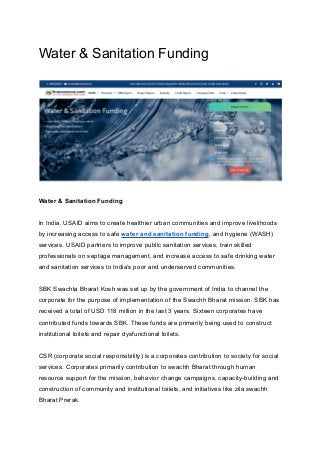Water & Sanitation Funding
•
0 likes•2 views
In India, USAID aims to create healthier urban communities and improve livelihoods by increasing access to safe water, sanitation, and hygiene (WASH) services. USAID partners to improve public sanitation services, train skilled professionals on septage management, and increase access to safe drinking water and sanitation services to India’s poor and underserved communities.
Report
Share
Report
Share
Download to read offline

Recommended
Recommended
More Related Content
More from Financeseva
More from Financeseva (20)
Water & Sanitation Funding
- 1. Water & Sanitation Funding Water & Sanitation Funding In India, USAID aims to create healthier urban communities and improve livelihoods by increasing access to safe water and sanitation funding, and hygiene (WASH) services. USAID partners to improve public sanitation services, train skilled professionals on septage management, and increase access to safe drinking water and sanitation services to India’s poor and underserved communities. SBK Swachta Bharat Kosh was set up by the government of India to channel the corporate for the purpose of implementation of the Swachh Bharat mission. SBK has received a total of USD 118 million in the last 3 years. Sixteen corporates have contributed funds towards SBK. These funds are primarily being used to construct institutional toilets and repair dysfunctional toilets. CSR (corporate social responsibility) is a corporates contribution to society for social services. Corporates primarily contribution to swachh Bharat through human resource support for the mission, behavior change campaigns, capacity-building and construction of community and institutional toilets, and initiatives like zila swachh Bharat Prerak.
- 2. Water and sanitation funding struggle to receive funding in the developing world, where governments are pressed with struggling economies, huge debts and a host of other socio-political problems. Most often, they have to priorities other basic social services, such as education and health, over water and sanitation. This problem is mainly an international problem and not just a problem of developing countries such as India. For instance, the most important measure to address the problem is debt relief – it can provide governments in Africa, some of which spend up to 60% of their national budget on foreign debt service payments, with already available funding. On the other hand, official development aid from member countries of the OECD Development Assistance Committee amounts on average to only 0.24% of their combined GNP. If these donors can meet the UN agreed target of ding aid amounting to 0.7% of GNP for only two years, it will eliminate the US$245 billion debt of all 41 Highly Indebted Poor Countries. There is a range of other sources of financing from private sector financing (bank loans and direct investments) to the reallocation of current government expenditures and to household and community financing. These are solutions that the international community needs to focus on. The political will necessary to get a tight grip on the problems and implement the solutions needs to be developed.
